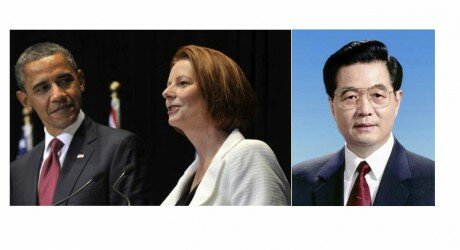America, China and Australia
Roy Hay
(This article appeared in the Geelong Advertiser, 28 November 2011, p. 18 as’ Red, white and blue in the top End.’)
A great deal has been made of the decision by Australia and the United States to have a training base for American troops in the top end.
Tandberg summed up a common response with a cartoon in which a US soldier says it is great to be in a country which offers no resistance for a change.
The old stories about Australia as the deputy sheriff in the Pacific got a good airing as well.
Then there were those who thought this was the USA throwing its weight around and setting up an imperial base in a client state so that it could dominate and contain China and probably India as well.
Barack Obama certainly set out to cheer up his regional allies with his affirmation that the United States would henceforth be a Pacific power and that it would continue to show leadership in the years to come.
Yet there is an alternative explanation for all of this which is perhaps nearer to the truth.
The United States is now entering a phase when it can no longer project its force in the way it often did in the last century.
Its aircraft carriers are now vulnerable to attack by Chinese weapons systems.
Even its nuclear submarines are no longer as safe as they were,
So the need for a land base astride the main sea lanes from the Pacific to the Indian Ocean rather than a maritime presence becomes pressing.
Moreover the United States cannot afford to maintain standing patrols and mobile forces on the scale it once did because of the huge costs of the Iraq and Afghanistan wars and the impact of the global financial crisis and its aftermath.
It might like to put its unemployed to work in war related industries as it did at the end of the Great Depression and during the early years of the Second World War before the Japanese attack on Pearl Harbor.
But that would be economic nonsense unless a war was imminent and there is no sign of that at present.
So the United States, whatever its leadership might claim, is probably trying to fend off the evil day when its economic capacity will be overtaken by China and this will no longer be able to be compensated for by superior technology.
The implications for Australia are also significant.
It is possible that Australia will become more valuable to the United States and thus have a greater capacity to influence United States policy than it does at present.
If Australia can maintain good relations with its northern neighbours, Indonesia and China, then it might be able to achieve the position of a force for peace and compromise when United States and Chinese interests diverge.
This is not going to happen overnight but in the longer term it is certainly possible.
In the meantime it is in Australia’s interests to take seriously the Indonesian President Susilo Bambang Yudhoyono’s suggestion that involving the Chinese military in the exercises with the United States in the Northern Territory would help defuse suspicions that the scheme is solely aimed at containing China.
There are those who want to divide the world into competing blocs and who see conflict between them as inevitable, but this is a despairing and desperate view of human relations.
There is just as much evidence in history of compromise and the ability of groups to maintain relatively peaceful relations as there is of hot wars between the leading powers of the day.
American and Chinese relationships can develop peacefully and Australia can play a part.
The fact that all parties have the capacity to end peace by resorting to conflict can have a sobering effect on each of them.
Predictability and openness are the keys and Australia, facing both ways, can have an influence for good in this uncertain and developing world.








Marnie Haig-Muir: Your review of the latest Rankin is right on the money, Roy. This book...